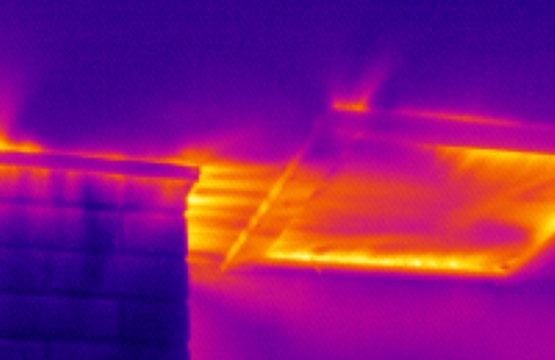

While an infrared camera’s standard lens is likely fine for most circumstances, the option to add a telephoto or wide-angle lens can prove useful in certain building inspection situations. First, if you are new to infrared and think you may have the need for an optional lens, know that not all camera models are designed for one, so be sure to check this before you buy. Also, these lenses are an optional accessory so be sure they fit within your budget.
A wide-angle lens can allow you to work more quickly and efficiently in tight spaces or where your perspective is not wide enough. This could include a scenario on the interior where you cannot view enough of an exterior wall in a small bedroom or perhaps shooting in an office without standing out in the hallway.

The above images illustrate what the field of view (FOV) looks like with each lens in a bathroom where the thermographer cannot back up any further. Each image has its unique message due to the perspective shown, but the wide-angle lens image shows more of the wall and ceiling, and therefore may be the best overall image of that corner of the bathroom. To show a similar image using a standard lens, the thermographer would have to take several more images to show a similar area as the wide-angle. Also, note that the instantaneous field of view (IFOV) is different for each lens. You can see this by looking for the nail heads in the molding around the window.
Another example of where a wide-angle lens might be useful is outside in a high-density residential neighborhood where yards are small or the spacing between buildings is tight. A wide-angle lens can help improve your limited viewing distance in this situation, allowing you to see more of the building in one shot.
If you are primarily inspecting larger structures, including multi-family units, high-rise apartments, or office buildings, a telephoto lens is certainly worth a consideration. The images below show an image of office space from the outside of a small commercial office building demonstrating the differences seen between a wide-angle, standard, and telephoto lens at distances of 100 feet/30.5 meters, as well as the same lenses at 36 feet/11 meters. Standing at the same spot for each set of images we can clearly see the changes to the field of view. The telephoto lens increases your resolution from this point, allowing you to see smaller areas of detail on the building at a greater distance.


On a final note about lenses, look at your imager and its digital zoom capability (available on some models). Note that using the zoom feature does not increase resolution and is not a replacement for an optional lens. It may work to some degree, on higher resolution imagers, such as a 640 x 480, if you zoom in to a 2x power setting, but in my experience the zoom seems to pixelate images significantly on lower resolution systems, especially when using the maximum zoom. Additionally, if your imager is equipped with optional lenses, it is important to remember to send those optional lenses with your imager whenever you send it to the manufacturer for calibration. Some optional lenses have their own properties that impact the amount of transmission of energy into the detector. If this is the case, the imager has to be calibrated with every lens that might be used with it. If you’re unsure if this is true for your particular imager, give the manufacturer a call and inquire.
It is important to note that the standard lens on an infrared camera sold for building applications is going to provide you with a sufficient and workable field of view to do your job in most situations, especially with residential applications. If, however, you feel you have the need—and the budget—an optional lens is definitely something to consider adding to your equipment list.